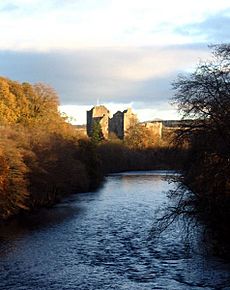Quia Emptores facts for kids
| Act of Parliament | |

|
|
| Long title | A Statute of our Lord The King, concerning the Selling and Buying of Land. |
|---|---|
| Citation | 18 Edw. 1. c. 1 |
|
Status: Amended
|
|
| Revised text of statute as amended | |
Quia Emptores was an important law made in England in 1290. It was passed by the Parliament of England during the time of King Edward I. This law changed how people could sell or give away their land.
Before this law, landowners could create new layers of landlords below them, a practice called subinfeudation. Quia Emptores stopped this. Instead, if you wanted to sell your land, the new owner would take your place directly under your original landlord. This law, along with another one called Quo Warranto, helped sort out land ownership problems. It also dealt with money issues that came from the old feudal system changing in England during the High Middle Ages.
The name Quia Emptores comes from the first two words of the law in its original Latin. It means "because the buyers". Its full official name is A Statute of our Lord The King, concerning the Selling and Buying of Land. It's also known as the Statute of Westminster III.
By stopping subinfeudation, Quia Emptores helped bring an end to feudalism in England. Feudalism was already fading, with cash payments replacing old duties. After this law, nobles could gather large amounts of land and money through direct sales. Some historians think this change might have even contributed to the Wars of the Roses later on.
As of 2020, parts of this old law are still used in England and Wales. It was removed from law in the Republic of Ireland in 2009. The law also affected how land was owned in places like Australia, colonial America, and even the modern United States.
Contents
What Does Quia Emptores Mean?
The name Quia Emptores means "because of the buyers" in Latin. It was traditionally translated as "Forasmuch as the Purchasers". These are the first words of the law. They explain why the law was created: to deal with "purchasers" who were using subinfeudation.
The law has other old Latin names too. In official records, it's called Statute qd null emat tras de aliis tenend qa de capitalibz dnis, &c.. In printed versions, it's known as Statutum Westm. iij. The Statute of Westminster the Third, viz. of Quia Emptores Terrarum.
How Land Ownership Changed in England
Land Before the Normans (Anglo-Saxon Times)
Before the Norman Conquest of England in 1066, land in England was often held by groups, not just one person. This was called folkland. It meant the land belonged to the community or family. The rules for who inherited land were based on old customs.
Norman Conquest and New Land Rules
After the Normans took over in 1066, William the Conqueror brought new rules. One big change was primogeniture. This meant the oldest son inherited all the family's land. The idea was to keep large land holdings together under a few powerful lords.
Younger sons or other people could still get land. They would become "under-lords" to the main heir. This was called subinfeudation. It meant a lord would grant land to someone, who then became their vassal. That new vassal could then grant parts of their land to someone else, creating another layer of vassal. This made a long chain of land ownership.
Over time, land ownership became more complicated. It was hard to know who owed what to whom in this feudal system. Eventually, even common people could pass land down to their children. This made them take better care of the land. It also meant land could be sold or given to the Church.
Problems with Feudal Land Ownership
In the feudal system, the lord who granted the land always kept some rights. The saying was: "Nulle terre sans seigneur" (No land without a lord). These rights included:
- An oath of fealty (loyalty).
- A regular payment, like a "quit rent".
- A "relief" payment when a new heir took over.
- The right of escheat, meaning the land went back to the lord if the tenant died without heirs.
But subinfeudation caused problems. If a lord granted land to a vassal, and that vassal then granted it to many others, the original lord might not get the services or payments they were owed. The new tenants had no direct link to the original lord. For example, if a vassal died, the lord might only get a small payment instead of control over the land.
Magna Carta and Land Rules
The Magna Carta of 1215 didn't say much about selling land. But later versions, like the Great Charter of 1217, started to limit how much land a free man could sell. It said: "No free man shall henceforth give or sell so much of his land as that out of the residue he may not sufficiently do to the lord of the fee the service which pertains to that fee." This meant you couldn't sell so much land that you couldn't perform your duties to your lord.
Selling Land by Peasants and Serfs
Peasants and serfs also used land. Many families stayed on the same land for generations. They often paid a fee (in goods or money) to live and farm the land. This was called socage. Once they paid, they were "soked" (paid in full).
It was found that peasants would farm better if they knew their children could inherit the land. This right to inherit soon led to the right to sell the land. But this caused arguments. If someone wanted to sell inherited land or give it to the Church, it raised questions about the rights of the overlord and other family members. Court rulings were often different, leading to confusion.
Why Quia Emptores Was Needed
By the late 1200s, land ownership was a mess. There hadn't been a full survey of land titles since the Domesday Book over 200 years earlier. It was hard to know who truly owned what. King Edward I wanted to make the laws clearer. He passed several important laws, including the Statute of Mortmain (1279), which tried to stop too much land from going to the Church. Quia Emptores (1290) was another step in this effort.
Before Quia Emptores, there were two main ways to sell land:
- Substitution: The seller would give up all rights and duties to the new buyer. The new buyer would then owe duties directly to the original lord.
- Subinfeudation: The seller would become a new lord to the buyer. The buyer would owe duties to the seller, not the original lord. This created new layers of landlords and made it hard for the top lords to get their services.
Quia Emptores was created to fix these problems.
What the Quia Emptores Law Did
The Quia Emptores law was like a clean-up act for land ownership. It aimed to fix confusion about:
- Who truly owned land.
- Gifts of land to the Church (frankalmoign).
- The practice of subinfeudation.
- "Middle lords" (mesne lords).
- Selling parts of land.
The main thing Quia Emptores did was to stop subinfeudation. It said that when land was sold, the seller had to give up all their rights and duties. The new buyer would then take the seller's place directly under the original lord. This meant no new "middle lords" could be created.
After Quia Emptores, selling land became a business deal, not a feudal one. The new owner was responsible for all the old feudal duties. However, the law did not apply to the King's land. Tenants who held land directly from the King still needed his permission to sell it.
The law also stopped new gifts of land to the Church (called frankalmoign), unless the King made the gift. This was because the Church didn't owe feudal services, which hurt the lords.
How Quia Emptores Changed Things Forever
Historians still discuss whether Quia Emptores was a new idea or just made existing practices official. But it's clear it helped formalize the buying and selling of land for money. It also helped end feudalism in England. Land was no longer just about loyalty and service; it was about ownership and money.
Many historians believe Quia Emptores was a win for the King. It helped him control land ownership better. It was also a compromise. It allowed people to keep selling land, but only by "substitution" (the new owner takes the old owner's place). This meant the great lords had to accept that tenants could sell their land. But the lords also gained because subinfeudation, which reduced their income from things like escheat (land returning to them) and wardship (control over young heirs), was stopped.
The process of escheat became clearer. If a tenant failed to perform their duties, it was still hard to remove them. But Quia Emptores helped define land tenures better.
After this law, new land grants could not be made as "frankalmoign" (gifts to the Church) unless from the King. Instead, they would be treated as socage, meaning they involved payments or services.
Quia Emptores in Other Countries
England and Wales
The Quia Emptores law still applies in England and Wales today, though it has been changed a lot over time. However, it does not apply to creating a leasehold estate (like renting a house), because a lease is not considered a feudal land ownership.
Ireland
The law was officially removed in the Republic of Ireland in 2009.
Colonial America and the United States
The English colonies in North America were often set up based on royal grants. This meant they followed some of the principles of Quia Emptores. For example, the Duke of York sold New Jersey in 1664 using deeds similar to how private land was sold in England.
Over time, Quia Emptores was mostly set aside in the colonies. But some parts might still affect land law in older states like New York, Virginia, Maryland, and Pennsylvania. Courts in the U.S. have had different opinions on whether Quia Emptores was ever truly in effect there. For example, a New York court in 1852 said it was never effective, but another New York court in 1859 said it always was.
Today, many U.S. states have laws or constitutions that say all land is "allodial." This means land is owned completely, not held under a lord. So, Quia Emptores is mostly a historical law in the U.S.
Old Words, New Meanings in U.S. Law
Even though Quia Emptores isn't directly used much in the U.S. today, many words from that old medieval time are still used in American land law. They have modern meanings, but their roots are in the feudal system:
- Alienation: Means "a sale" of property.
- Appurtenant: Means "belonging to" something else, like a right belonging to a piece of land.
- Demise: Means "to lease" or "rent" property.
- Estate: Means "an interest in land," like owning it fully or just having the right to use it.
- Feoffee: A person to whom land is given.
- Leasehold: The right to hold land under a lease.
- Mesne: Means "intervening," often used for a "middle" transfer of property.
- Purchase: Means "voluntary transfer of property."
- Seisin: Means "possession of a freehold estate" (full ownership).
- Tenant: Someone who holds or uses land under some right.
Terms like "fee simple" (full ownership of land) are still used today, and they come from laws like De Donis Conditionalibus from 1285, which was passed around the same time as Quia Emptores.




